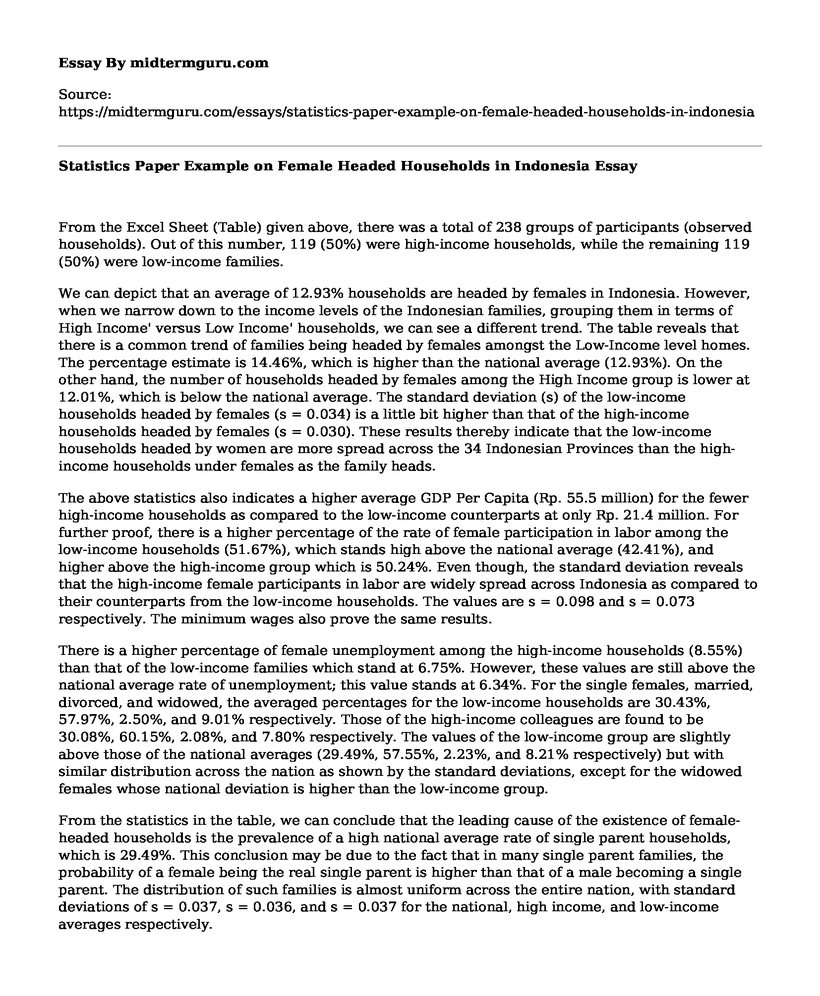From the Excel Sheet (Table) given above, there was a total of 238 groups of participants (observed households). Out of this number, 119 (50%) were high-income households, while the remaining 119 (50%) were low-income families.
We can depict that an average of 12.93% households are headed by females in Indonesia. However, when we narrow down to the income levels of the Indonesian families, grouping them in terms of High Income' versus Low Income' households, we can see a different trend. The table reveals that there is a common trend of families being headed by females amongst the Low-Income level homes. The percentage estimate is 14.46%, which is higher than the national average (12.93%). On the other hand, the number of households headed by females among the High Income group is lower at 12.01%, which is below the national average. The standard deviation (s) of the low-income households headed by females (s = 0.034) is a little bit higher than that of the high-income households headed by females (s = 0.030). These results thereby indicate that the low-income households headed by women are more spread across the 34 Indonesian Provinces than the high-income households under females as the family heads.
The above statistics also indicates a higher average GDP Per Capita (Rp. 55.5 million) for the fewer high-income households as compared to the low-income counterparts at only Rp. 21.4 million. For further proof, there is a higher percentage of the rate of female participation in labor among the low-income households (51.67%), which stands high above the national average (42.41%), and higher above the high-income group which is 50.24%. Even though, the standard deviation reveals that the high-income female participants in labor are widely spread across Indonesia as compared to their counterparts from the low-income households. The values are s = 0.098 and s = 0.073 respectively. The minimum wages also prove the same results.
There is a higher percentage of female unemployment among the high-income households (8.55%) than that of the low-income families which stand at 6.75%. However, these values are still above the national average rate of unemployment; this value stands at 6.34%. For the single females, married, divorced, and widowed, the averaged percentages for the low-income households are 30.43%, 57.97%, 2.50%, and 9.01% respectively. Those of the high-income colleagues are found to be 30.08%, 60.15%, 2.08%, and 7.80% respectively. The values of the low-income group are slightly above those of the national averages (29.49%, 57.55%, 2.23%, and 8.21% respectively) but with similar distribution across the nation as shown by the standard deviations, except for the widowed females whose national deviation is higher than the low-income group.
From the statistics in the table, we can conclude that the leading cause of the existence of female-headed households is the prevalence of a high national average rate of single parent households, which is 29.49%. This conclusion may be due to the fact that in many single parent families, the probability of a female being the real single parent is higher than that of a male becoming a single parent. The distribution of such families is almost uniform across the entire nation, with standard deviations of s = 0.037, s = 0.036, and s = 0.037 for the national, high income, and low-income averages respectively.
Conclusively, the top three Indonesian Provinces leading in the average numbers of the female-headed households include Jakarta, East Kalimantan, and Riau Provinces. The provinces with the lowest number of female-headed households on average include the East Nusa Tenggara, West Nusa Tenggara, and Maluku.
Cite this page
Statistics Paper Example on Female Headed Households in Indonesia . (2021, Jun 10). Retrieved from https://midtermguru.com/essays/statistics-paper-example-on-female-headed-households-in-indonesia
If you are the original author of this essay and no longer wish to have it published on the midtermguru.com website, please click below to request its removal:
- Apple Inc Organization Description Paper Example
- Protests, Crisis, and Countercultures Worksheet
- Essay Sample on Intercultural Communication
- Essay Sample on Multiculturalism in American Society
- International Expansion to Canada: Social and Cultural Risks - Essay Sample
- Serving Humanity: A Call to All - Essay Sample
- Research Paper on African Americans and the Criminal Justice System







